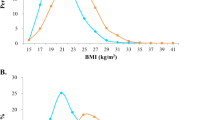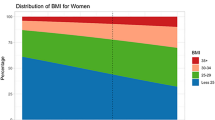Summary
This paper examines regional changes in the prevalence of overweight (BMI ³ 25 kg/m²) and obesity (BMI ³ 30 kg/m²) among Austrian adults (aged ³ 20 years) during a 35-year period, taking into account the social inequality with regard to obesity. Self-reported data from five cross-sectional nationally representative surveys (n = 178,818) conducted between 1973 and 2007 were analysed. The prevalence of overweight was higher in men than women (2007: 46.3 vs. 31.2 %;p < 0.001) and similar in all Austrian regions. There was a clear east-west gradient for obesity among both sexes, with the highest rates in Eastern Austria (in 2007, women: 18.1 %, men: 16.1 %;p < 0.001) and the lowest in Western Austria (in 2007, women: 12.6 %, men: 11.7 %;p < 0.001). Logistic regression analyses have shown a general decrease of overweight per year among women (OR = 0.991, 95 % CI 0.990–0.993) and men (OR = 0.999, 95 % CI 0.998–1.000), while the obesity prevalence has risen during the study period in every region (women: OR = 1.003, 95 % CI 1.001–1.005; men: OR = 1.011, 95 % CI 1.009–1.013), with the highest increase among women in Central Austria and men in Western Austria. Social inequalities for obesity showed a tendency to increase in the Western and Eastern region. Our results showed a significant regional difference for obesity prevalence during the entire study period. Obesity is a frequent health problem among Austrian adults residing in the Eastern region.
Zusammenfassung
Diese Studie untersucht regionale Veränderungen in der Prävalenz von Übergewicht (BMI ³ 25 kg/m²) und Adipositas (BMI ³ 30 kg/m²) bei Erwachsenen (³ 20 Jahre) in Österreich innerhalb eines 35-jährigen Untersuchungszeitraums. Im Hinblick auf Adipositas wurde des Weiteren die soziale Ungleichheit innerhalb der Regionen analysiert. Selbstberichtete Daten aus fünf nationalen repräsentativen Querschnittstudien (n = 178.818), die zwischen 1973 und 2007 erhoben wurden, wurden zur Analyse herangezogen. Die Prävalenz von Übergewicht war bei Männern höher als bei Frauen (2007: 46,3 vs. 31,2 %;p < 0,001) und in allen Regionen ähnlich verteilt. Im Hinblick auf Adipositas lag für beide Geschlechter ein deutliches Ost-West Gefälle vor, mit der höchsten Rate in Ostösterreich (in 2007, Frauen: 18,1 %, Männer: 16,1 %;p < 0,001) und der niedrigsten in Westösterreich (in 2007, Frauen: 12,6 %, Männer: 11,7 %;p < 0.001). Die logistische Regression zeigte eine jährliche Abnahme von Übergewicht bei Frauen (OR = 0,991, 95 % CI 0,990–0,993) und Männern (OR = 0,999, 95 % CI 0,998–1,000), während die Adipositasprävalenz in jeder Region zunahm (Frauen: OR = 1,003, 95 % CI 1,001–1,005; Männer: OR = 1,011, 95 % CI 1,009–1,013). Betrachtet man die absoluten Veränderungen der Adipositasprävalenz, so gab es den stärksten Anstieg bei Frauen in Zentralösterreich und Männern in Westösterreich. Eine steigende Tendenz hinsichtlich der sozialen Ungleichheit bei Adipositas gab es für West- und Ostösterreich. Unsere Ergebnisse zeigten signifikante regionale Unterschiede in der Adipositasprävalenz. Adipositas stellt vor allem ein häufiges Gesundheitsproblem bei Erwachsenen in Ostösterreich dar.


Similar content being viewed by others
References
World Health Organization. Obesity and Overweight. 2012.http://www.who.int/mediacentre/factsheets/fs311/en/index.html. Accessed 29 Feb 2012.
James WPT. The epidemiology of obesity: the size of the problem. J Intern Med. 2008;263:336–52.
Kiefer I, Kunze M. Epidemiologie der Adipositas. Wien Klin Wochenschr. 2004;154:296–9.
Finucane MM, Stevens GA, Cowan MJ, et al. National, regional, and global trends in body-mass index since 1980: systematic analysis of health examination surveys and epidemiological studies with 960 country-years and 9.1 million participants. Lancet. 2011;377:557–67.
Cámara AD, Spijker JJ. Super size Spain? A cross-sectional and quasi-cohort trend analysis of adult overweight and obesity in an accelerated transition country. J Biosoc Sci. 2010;42:377–93.
Diouf I, Charles MA, Ducimetière P, Basdevant A, Eschwege E, Heude B. Evolution of obesity prevalence in France: an age-period-cohort analysis. Epidemiology. 2010;21:360–5.
Ford ES, Li C, Zhao G, Tsai J. Trends in obesity and abdominal obesity among adults in the United States from 1999–2008. Int J Obes. 2011;35:736–43.
Marques-Vidal P, Bovet P, Paccaud F, Chiolero A. Changes of overweight and obesity in the adult Swiss population according to educational level, from 1992–2007. BMC Public Health. 2010;22:87.
Lahti-Koski M, Seppänen-Nuijten E, Mannistö S, Härkänen T, Rissanen H, Knekt P, et al. Twenty-year changes in the prevalence of obesity among Finnish adults. Obes Rev. 2010;11(3):171–6.
Singh-Manoux A, Gourmelen J, Lajnef A, Sabia A, Sitta R, et al. National prevalence of obesity. Prevalence of educational inequalities in obesity between 1970 and 2003 in France. Obes Rev. 2009;10:511–8.
Charles M-A, Eschwège E, Basdevant A. Monitoring the obesity epidemic in France: the Obepi surveys 1997–2006. Obesity. 2008;16:2182–6.
Faeh D, Marques-Vidal P, Chiolero A, Bopp M. Obesity in Switzerland: do estimates depend on how body mass index has been assessed? Swiss Med Wkly. 2008;138:204–10.
Berghöfer A, Pischon T, Reinhold T, Apovian CM, Sharma AM, Willich SN. Obesity prevalence from a European perspective: a systematic review. BMC Public Health. 2008;8:200.
Lidstone J, Wilkinson JR, Bailey K. Occasional Paper No. 10 Obesity and overweight in Europe. Lessons from France. University of Durham. 2005.http://www.nepho.org.uk/publications.php5?rid=506. Accessed 29 Feb 2012.
Panagiotakos DP, Pitsavos C, Chrysohoou C, Risvas G. Epidemiology of overweight and obesity in a Greek population: the ATTICA study. Obes Res. 2004;12:1914–20.
Raben, A. Jumbosize Europe?: European Union conference on obesity calls for immediate action. Food Nutr Res. 2003;47(1):29–38.
Schober E, Rami, B, Kirchengast S, Waldhör T, Sefranek R. Recent trend in overweight and obesity in male adolescents in Austria: a population-based study. Eur J Pediatr. 2007;166:709–14.
Kirchengast S, Schober E, Waldhör T, Sefranek R. Regional and social differences in body mass index, and the prevalence of overweight and obesity among 18 year old men in Austria between the years 1985 and 2000. Coll Antrpol. 2004;28(2):541–52.
Dorner T, Leitner B, Stadlmann H, Fischer W, Neidhart B, et al. Prevalence of overweight and obesity in Austrian male and female farmers. Soz.-Präventivmed. 2004;49:243–6.
Singh-Manoux A, Gourmelen J, Lajnef A, Sabia A, Sitta R, et al. National prevalence of obesity. Prevalence of educational inequalities in obesity between 1970 and 2003 in France. Obes Rev. 2009;10:511–8.
Wardle J, Griffith J. Socioeconomic status and weight control practices in British adults. J Epidemiol Comm Health. 2001;55:185–90.
Helmert U, Strube H. Die Entwicklung der Adipositas in Deutschland im Zeitraum von 1985–2002. Gesundheitswesen. 2004;66:409–15.
Charafeddine R, Van Oyen H, Demarest S. Trends in social inequalities in obesity: Belgium, 1997–2004. Prev Med. 2009;48:54–8.
Yoo S, Cho HJ, Khang YH. General and abdominal obesity in South Korea, 1998–2007: gender and socioeconomic differences. Prev Med. 2010;56:460–5.
Großschädl F, Haditsch B, Stronegger WJ. Validity of self-reported weight and height in Austrian adults: sociodemographic determinants and consequences for the classification of BMI categories. Publ Health Nutr. 2011;11:1–8.
Regidor E. Measures of health inequalities: part 2. J Epidemiol Comm Health. 2004;58:900–3.
Berg C, Rosengren A, Aires N, Lappas G, Torén K, et al. Trends in overweight and obesity from 1985–2002 in Göteborg, West Sweden. Int J Obes. 2005;29:916–24.
Marques-Vidal P, Bovet P, Paccaud F, Chiolero A. Changes of overweight and obesity in the adult Swiss population according to educational level, from 1992–2007. BMC Public Health. 2010;22:87.
Gutiérrez-Fisac JL, Banegas Banegas JR, Rodrígue Artalejo F, Regidor E. Increasing prevalence of overweight and obesity among Spanish adults, 1987–1997. Int J Obes. 2000;24:1677–82.
Powell KE, Roberts AM, James GR, Phillips MAC, Ujamaa DA, et al. Low physical fitness among fifth- and seventh-grade students, Georgia, 2006. Am J Prev Med. 2009;36(4):304–10.
Gualdi-Russo E, Zironi A, Dallari GV, Toselli S. Migration and health in Italy: a multiethnic adult sample. J Trav Med. 2009;16(2):88–95.
Delva J, Johnston LD, O’Malley PM. The epidemiology of overweight and related lifestyle behaviors: racial/ethnic and socioeconomic status differences among American youth. Am J Prev Med. 2007;33:178–86.
Ahluwalia IB, Mack KA, Murphy W, Mokdad AH, Bales VS. State-specific prevalence of selected chronic disease-related characteristics-behavioral risk factor surveillance system, 2001. MMWR Surveill Summ. 2003;52:1–80.
Kirchengast S, Schober E. Obesity among female adolescents in Vienna, Austria—the impact of childhood weight status and ethnicity. Int J Obstet Gynaecol. 2006;113:1188–94.
Sulander TT, Uutela AK. Obesity and education: recent trends and disparities among 65- to 84-year-old men and women in Finland. Prev Med. 2007;45:153–6.
Seidell JC. Epidemiology of obesity. Semin Vasc Med. 2005;5:3–14.
Low S, Chin MC, Deurenberg-Yap M. Review on epidemic of obesity. Ann Acad Med Singapore. 2009;38:57–9.
Andersen S, Mulvad G, Pedersen HS, Laurberg P. Gender diversity in develo** overweight over 35 years of westernization in an Inuit hunter cohort and ethno-specific body mass index for evaluation of body-weight abnormalities. Eur J Endocrinol. 2004;151:735–40.
Grabauskas V, Petkeviciene J, Klumbiene J, Vaisvalavicius V. The prevalence of overweight and obesity in relation to social and behavioral factors (Lithuanian health behaviour monitoring). Medicina. 2003;39:1223–30.
Chhabra P, Chhabra S. Distribution and determinants of body mass index of non-smoking adults in Delhi, India. J Health Popul Nutr. 2007;25(3):294–301.
Sabbah I, Vuitton D-A, Droubi N, Sabbah S, Mercier M. Morbidity and associated factors in rural and urban populations of South Lebanon: a cross-sectional community based study of self-reported health in 2000. Trop Med Internat Health. 2007;12(8):907–19.
Yadav K, Krishnan A. Changing patterns of diet, physical activity and obesity among urban, rural and slum populations in north India. Obes Rev. 2008;9:400–8.
Jackson JE, Doescher MP, Jerant AF, Hart LG. A national study of obesity prevalence and trends by type of rural county. J Rural Health. 2005;21(2):140–8.
Wadden TA, Brownell KD, Foster GD. Obesity: responding to the global epidemic. J Consult Clin Psychol. 2002;70:510–25.
Conflict of interest
The authors declare that there is no conflict of interest.
Author information
Authors and Affiliations
Corresponding author
Rights and permissions
About this article
Cite this article
Großschädl, F., Stronegger, W. Regional trends in obesity and overweight among Austrian adults between 1973 and 2007. Wien Klin Wochenschr 124, 363–369 (2012). https://doi.org/10.1007/s00508-012-0175-4
Received:
Accepted:
Published:
Issue Date:
DOI: https://doi.org/10.1007/s00508-012-0175-4




